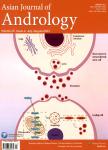The prognostic significance of percentage of tumour involvement according to disease risk group in men treated with radical prostatectomy
The prognostic significance of percentage of tumour involvement according to disease risk group in men treated with radical prostatectomy作者机构:Department of Urology Seoul National University Bundang Hospital Seongnam Kyunggi-do 463-707 Korea Department of Pathology Seoul National University Bundang Hospital Seongnam Kyunggi-do 463-707 Korea
出 版 物:《Asian Journal of Andrology》 (亚洲男性学杂志(英文版))
年 卷 期:2011年第13卷第6期
页 面:828-832页
核心收录:
学科分类:0710[理学-生物学] 090602[农学-预防兽医学] 1002[医学-临床医学] 07[理学] 08[工学] 09[农学] 0906[农学-兽医学] 071007[理学-遗传学] 0901[农学-作物学] 0836[工学-生物工程] 090102[农学-作物遗传育种]
主 题:biochemical recurrence-free survival percentage of tumour involvement prognosis prostate cancer prostatectomy
摘 要:We investigated the prognostic significance of percentage of tumour involvement (PTI) according to the clinicopathological features of prostate cancer among patients who underwent radical prostatectomy (RP). A retrospective study of 534 patients who underwent RP between September 2003 and March 2008 without any neoadjuvant or adjuvant therapy was performed. The associations of PTI with various clinicopathological features and biochemical recurrence-free survival were examined via uni- and multivariate analyses. The predictive accuracy of the multivariate model was assessed with a receiver operating characteristics-derived area under the curve. PTI was demonstrated to be significantly associated with preoperative prostate-specific antigen (PSA) level (P=0.001), pathological Gleason score (P〈0.001), extraprostatic tumour extension (P〈0.001), seminal vesicle invasion (P〈0.001) and positive surgical margin (P〈0.001) in univariate analyses. When patients were stratified into disease risk groups, PTI was an independent predictor of biochemical recurrence-free survival in multivariate analysis only among the low-risk group (P=0.033) but not the intermediate- (P=0.287) or the high-risk groups (P=0.828). The addition of the PTI did not significantly increase the accuracy of the multivariate model devised for the prediction of biochemical recurrence-free survival among both total patients (P=-0.459) and the low-risk group (P=0.268), respectively. In conclusion, although PTI appeared to be a more significant prognostic factor among patients with low-risk disease than among those with higher risk diseases, overall, the PTI may not provide additional prognostic information beyond what can already be obtained via established prognostic factors.



